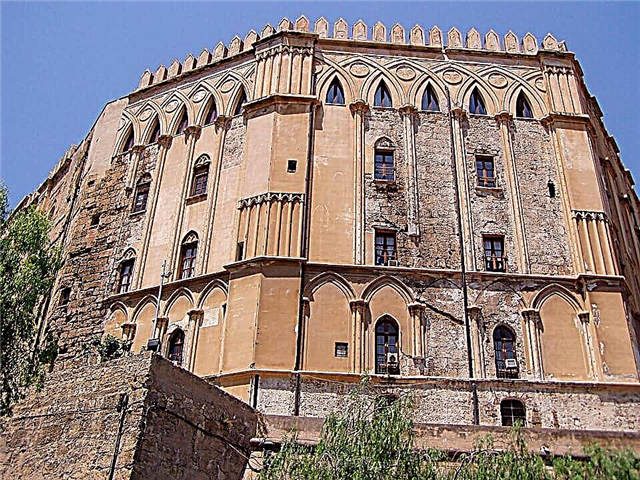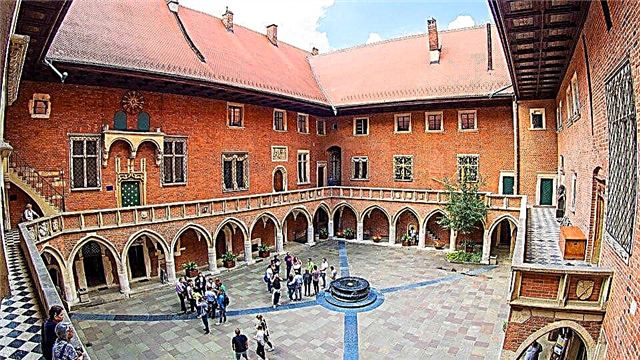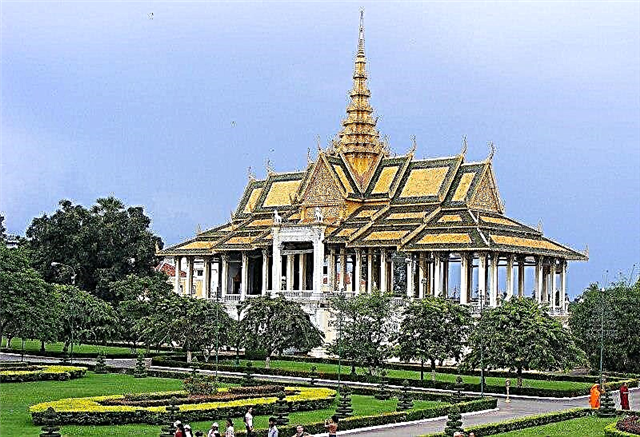Address: Russia, Nizhny Novgorod region, Nizhny Novgorod, Rozhdestvensko street, 34A
Start of construction: 1696 year
Completion of construction: 1719 year
Architect: Dal L.V., Kilevein R.Ya.
Shrines: the icon of St. Nicholas the Wonderworker, icons with particles of the relics of St. Seraphim of Sarov, Metropolitan Philaret of Moscow, the Optina elders in the reliquary, the miraculous Sovereign Icon of the Mother of God.
Coordinates: 56 ° 19'38.4 "N 43 ° 59'06.6" E
Content:
The lavishly decorated church of the Cathedral of the Most Holy Theotokos is called Rozhdestvenskaya along the street on which it stands, or Stroganovskaya by the name of the famous Russian salt producer who allocated money for its construction. The throne of this church is dedicated to the Orthodox holiday - the Cathedral of the Most Holy Theotokos. Red-brick walls, intricate white-stone carvings and multi-colored domes have become a real decoration of the city and are perfectly visible from everywhere.

View of the church from Suetinskaya street
Christmas street
The street connecting the square in front of the Annunciation Monastery with the National Unity Square near the Nizhny Novgorod Kremlin is unique in its own way. It is a real open-air museum. Here you can see houses built in the middle of the 18th century and the picturesque church of the Cathedral of the Most Holy Theotokos. All in all, in this part of the city there are 35 cultural heritage sites - architectural monuments protected by the state.
The place where the street is now was inhabited a long time ago, from the very foundation of the city. The famous engineer and designer Augustine Bettencourt (early 19th century) ordered that in order to avoid fires, the street was built up with stone buildings and, demolishing dilapidated houses, straightened. Years passed and this street turned into the business center of Nizhny Novgorod.
History of the Assumption Church
The construction of the temple has a rather long history and is associated with the fate of the Russian businessman, merchant and politician, a representative of the eminent noble family of the Stroganovs - Grigory Dmitrievich. Grigory was the only son of Dmitry Andreevich Stroganov. As an inheritance from his father, he received rich estates - several towns, villages and villages, as well as more than 1.5 thousand serfs.

General view of the church
Natural intelligence and entrepreneurial flair allowed Grigory Stroganov to significantly increase the family wealth, and he became the owner of more than 200 villages, where 15 thousand serfs lived. In Nizhny Novgorod, Stroganov had great commercial interests, since it was profitable to trade in salt here. In 1696, the construction of a stone church began in the city with the money of a salt industrialist. In five years, this church was almost built, but there was a big fire, and the new, not yet opened church was badly damaged.
In 1703, a state monopoly on the production and trade of salt was introduced in Russia, and therefore Nizhny Novgorod ceased to be of interest to Stroganov, and he did not even appear in the city. As the researchers suggest, Stroganov simply stopped financing the construction of the temple, and the construction was suspended for many years.
In 1715, at the age of 59, Stroganov died, and his widow Maria Yakovlevna undertook to complete the church. Thanks to her efforts and the allocated funds, the interior decoration was carried out in the temple and in 1719 the throne was consecrated. The church became a home church in the city estate of the Stroganovs.
Only two years passed, and Tsar Peter I closed the Stroganov church by personal decree. Therefore, services were not held here until the death of the sovereign in 1725.

General view of the church and bell tower against the background of the Kanavinsky bridge
It is also known from the history of the church that it suffered several times during the fires. Particularly strong destruction occurred in the 60s-80s of the 18th century. However, at the beginning of the 19th century, the temple was thoroughly restored at the expense of Grigory Stroganov's grandson, Alexander Sergeevich Stroganov.
The next reconstruction of the temple took place in the 1820s, and they were led by Augustin Betancourt and the academician of architecture Ivan Efimovich Efimov. They understood how important it was to preserve the most beautiful Stroganov church, and decided to strengthen it with a special additional wall, and connect the bell tower building, which used to stand separately, with the porch by means of a new covered passage. Interestingly, during this reconstruction, brick was used, left over from the dismantled old Nativity Church, which gave the name to the street.
In 1860, due to subsidence of the ground, the temple bell tower began to give a noticeable tilt. Over the next two decades, it deviated from the vertical position by 1.2 m. The situation was so critical that the building could collapse at any moment. Therefore, it was necessary to urgently replace the foundation and the upper tiers of the bell tower (1887). These works were supervised by the famous Nizhny Novgorod architects Lev Vladimirovich Dal and Robert Yakovlevich Kilevein. And the last major restoration before the revolution took place in the church in 1913.

View of the church from Rozhdestvenskaya street
After the coming of Soviet power, the fate of the church changed. At first, they just wanted to destroy it. Father Sergiy (Veisov), who was the rector of the church since 1915, made a lot of efforts to make the old church recognized as an architectural monument. He collected documents and old photographs, lectured on the significance of the Stroganov Baroque and achieved his goal. The temple was not touched, but during the active anti-religious struggle, church services were banned here (1934). The city's atheist museum was housed inside the building. And its first director was appointed the former abbot of the temple - Veisov, and the watchman - Hieromonk Spiridon.
Restoration and restoration work in the temple began after it was returned to the believers (1992). A year later, the church was re-consecrated.
Bell tower clock
A very interesting story is connected with the "astronomical" clock that once adorned the temple. They broke down in 1750. And the only one who managed to fix the watch was a 15-year-old teenager Ivan Kulibin - later a renowned Russian master, nicknamed "the Nizhny Novgorod Archimedes". Unfortunately, old watches with a unique mechanism have not survived to this day.
Then an ordinary clock was installed on the belfry, beating off the ringing every hour, but by the beginning of the 20th century, they broke. Old Slavic letters are still visible on the stone slabs around the clock, which divide the circle not into 12, but into 17 parts, as was customary in Ancient Rus.

View of the south facade of the church
In 2005, on a two-tiered bell tower crowned with a cross and a weather vane, another tower clock was installed, which has no less interesting history. In 1879, this unusual movement was made by German craftsmen at the factory of Johann Friedrich Voile. At first, the clock was placed on the building of the Blinovsky passage, which also stands on Rozhdestvenskaya Street, not so far from the Stroganov Church. In 1917, the clockwork was removed from there, and until recently it was kept in the city history museum.
In the 1990s, they tried to mount the old clock on the belfry of the church, but they did it ineptly, and the clockwork did not work. In 2004, the Kaluga master Alexander Georgievich Krasnikov took over the restoration of the clock. He was able to completely restore the original movement, and only four hour dials had to be replaced. Today, an 80-kilogram bell, placed in the upper part of the bell tower, beats the right time every hour, and one beat is heard over the temple every half hour. Interestingly, the antique watches are completely mechanical and require manual winding once every two weeks.

Church bell tower
The architecture of the temple and its interior decoration
The Nativity Church is one of four Stroganov Baroque monuments preserved in Russia. Outwardly, this church resembles a precious carved box. Its facades are covered with magnificent stone carvings, on which you can see images of intricate shells and curls, vines of grapes, flowers and beautiful fruits.
The temple is two-tiered and has a three-apse altar and a pillarless refectory. From above it is crowned with five chapters, set to the cardinal points. Initially, their domes were green, but since the end of the 19th century, the domes have been painted in different colors, like the Intercession Cathedral on Moscow's Red Square.
The current state of the temple and the visiting regime
The Orthodox church is active, and its doors are open to all comers - believers and tourists on any day. Services in the church are held daily. The patronal feast is celebrated here on January 8th.
Particularly revered temple shrines are considered the ancient icon of St. Nicholas, the copy of the icon of the Mother of God "Reigning", as well as several icons with particles of relics of Christian saints.

Domes of the Nativity Church
How to get there
The temple is located at 34A Rozhdestvenskaya Street. You can approach it by trams, buses and minibuses (the Rechnoy Vokzal stop).











